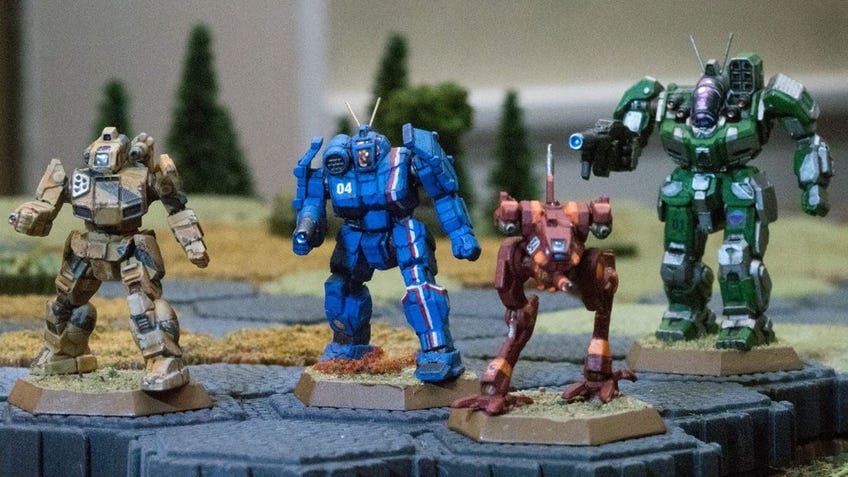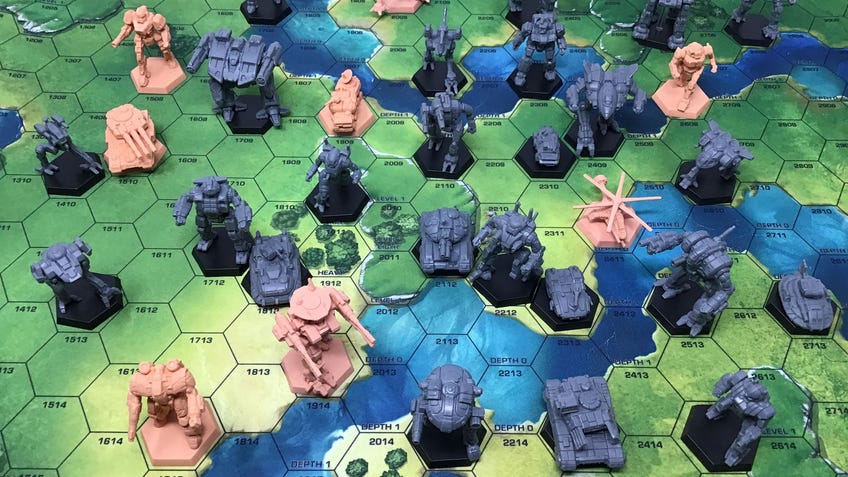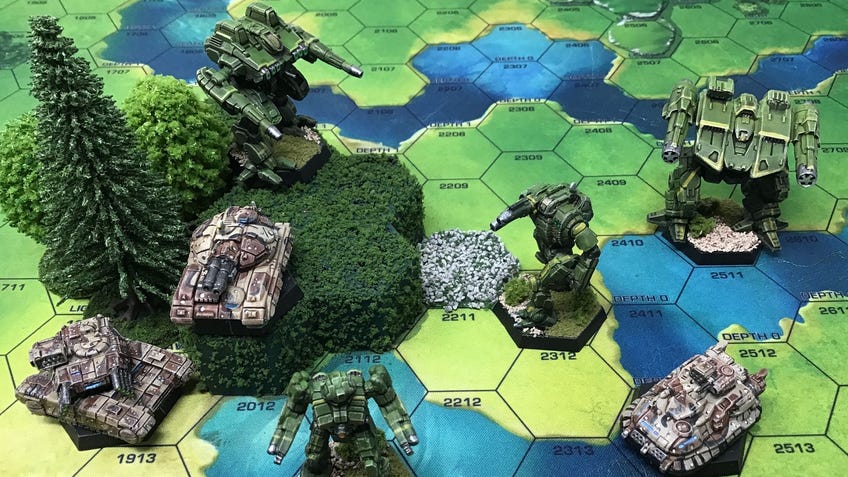Mech miniatures classic BattleTech is a surprisingly approachable, affordable - and brilliantly compelling - way into wargaming
The decades-old franchise continues to be well worth picking up for the first time.
Edition fatigue is a real problem. While I’m very excited for the release of Warhammer 40,000: 10th Edition, it’s still annoying that a bunch of books on my shelf are going to be completely invalidated, and I really feel for the Astra Militarum and World Eaters players who will get less than a year’s use out of their codices before the new edition drops. If you’re tired of three-year edition cycles and regular sweeping rules changes, I have the perfect game for you: BattleTech.
I’ve recently gotten into BattleTech in a big way after a regular gaming pal dragged me in. It wasn’t a hard sell; I make no secret of my love for giant robots, and it’s not the first time I’ve played the game. My initial encounter with BattleTech was the fourth-edition box released way back in 1996 and, while not quite as far in the dim and distant past as my first forays into Warhammer, the game I played then was pretty much the same as it is now. As a result, the game has decades of fiction, sourcebooks and miniatures that are all as relevant as the day they were first produced. At the same time Catalyst Game Labs, the game’s current steward, has spent the last few years releasing a range of products that make the game more approachable than ever.
There is an overwhelming amount of background material available for BattleTech, but the core is pretty simple. Set roughly a thousand years from now, humanity has colonised a chunk of our galaxy known as the Inner Sphere. Containing around 2,000 habitable planets which were once united as the Star League, there are now a bunch of factions duking it out for territory and resources. Probably a good thing for a wargame setting, really! While there are conventional tanks, infantry and so on, the focus is on 12-metre-tall (give or take) BattleMechs, powered by fusion engines and stuffed with as much weaponry and armour as their 20 to 100-ton frames can carry.
Modern BattleTech is more approachable than ever.
Even if you’ve never encountered the tabletop game before, there’s a good chance you’re at least aware of BattleTech’s setting through the various video game adaptations that have been knocking around since the ‘80s. Chief among them is the MechWarrior series of action games that put you right in the cockpit of a BattleMech. Originally released in 1989, the series’ latest game, MechWarrior 5, had new DLC just a couple of months ago. Harebrained Schemes’ 2018 turn-based BattleTech was also well-received and, while not a direct translation of the tabletop rules, is highly recommended if you want to get a taste for ‘mech combat. There was even a BattleTech cartoon released in the early 90s, which you can find on YouTube - but I’d be hard-pressed to recommend it. I’m an aficionado of ‘80s and ‘90s cartoons and even I find it too cringeworthy.

The tabletop game itself revolves around the aforementioned ‘mechs unleashing their arsenals in an attempt to make their opponents blow up. Or fall over. Or fall over and then blow up. Or step into a lake to cool down, flooding their armour-stripped legs - before they fall over and blow up. Rather than any kind of measuring tools or tape measures, BattleTech uses maps marked with grids of hexagons; both range and movement involve simply counting hexes. Shooting and other actions are resolved with a pair of regular six-sided dice, though having a bunch of extra ones in different colours helps track how fast units are moving around the map.
This sort of thing is important, because BattleTech is a very detailed game, especially compared to more modern fare. Each ‘mech you field requires an accompanying record sheet to track ammo, damage and the heat generated by various weapons and systems. You need to know how fast a mech moved and whether it walked, ran or activated its jump jets, because these all add negative modifiers to your attacks. At the same time, moving quickly makes it harder for enemies to line up a clear shot on you. The result is a game of movement and manoeuvre, checking fire arcs and ranges and carefully managing heat levels so that your ‘mechs don't shut down mid-combat.

This highly-granular detail is going to be immediately off-putting to a lot of people, which is absolutely valid. BattleTech is resolutely old-school in its stylings and that’s never going to change. It is a detailed system, but it’s also relatively straightforward, with the vast majority of the information you need right there on the record sheet. Even trying to teach the game to my partner at home while I was still learning myself, it was rare that I had to pick up the 50-page rulebook, instead only needing to check the quick reference sheet for a modifier or a damage chart. On top of that, the payoff can be spectacular, thanks to critical hits.
BattleTech is a very detailed game, especially compared to more modern fare, but it’s also relatively straightforward.
BattleMechs can take hits on their armour without any ill effect, and can even function normally with damaged limbs, right up until they take enough damage to be destroyed entirely. If that was the only way to take down a ‘mech, it’d make for one dull slugfest of a game. Critical hits make things much more interesting. Once a location (‘mechs are divided into eight sections, one for each limb and three for the torso) has been stripped of armour, further hits have a chance to take out important systems, causing the loss of weapons, degradation of performance, or even ammo explosions that can cascade and rip a ‘mech to shreds. It’s even possible for a lucky headshot to kill the pilot and take out an otherwise undamaged ‘mech!
It’s a huge part of what makes the game so approachable. The level of detail means that even a simple duel between two ‘mechs can make for an engaging game filled with dramatic moments. A game with four ‘mechs a side, which is exactly what comes in the A Game of Armoured Combat core box, can provide a solid evening’s entertainment comparable to 1,000 to 2,000 points of Warhammer. It’s an inarguably economical game, especially with the use of map sheets reducing the need for terrain on top of miniatures. The appropriately-named Beginner Box can be had for £20 and includes two miniatures, dice, a map sheet and an introductory version of the rules that teaches you the basics.
The various boxed sets produced by Catalyst make for a smooth route into the game, allowing players to ignore the decades of era guides, technical readouts and other source material until they feel like diving deep into the setting. A Game of Armoured Combat builds on the introductory rules of the Beginner Box, without making anything contained within obsolete. (Many veteran players picked up the Beginner Box just for the new models and map sheet.) Clan Invasion advances the timeline of the game and introduces the hi-tech omnimechs of the Clans, as well as their power-armoured Elemental troops.

If larger-scale battles are more your thing, there’s also Alpha Strike. The primary weakness of BattleTech’s detailed approach is that it makes games with anything more than a handful of mechs into a bit of a chore. While it’s perfectly possible to portray larger engagements, be prepared to set aside a day - or even a whole weekend - to do so. That’s where Alpha Strike comes in, with streamlined profile cards for ‘mechs instead of the larger record sheets, enabling much bigger battles. It also does away with the hex grids, instead measuring with inches on more traditional wargaming terrain. The Alpha Strike box includes everything you need to play, including some adorable folding card buildings and trees. All of the miniatures for the two variants are the same, and boxes of miniatures come with Alpha Strike profile cards for the ‘mechs contained within.
It’s an inarguably economical game, with the use of map sheets reducing the need for terrain on top of miniatures.
As you might imagine, there have been a bunch of different miniature ranges produced for BattleTech over the years. The most readily available now are the pre-assembled plastic miniatures included in the various boxed sets and ‘force packs’ of four to six ‘mechs. Made of a softer plastic than Citadel miniatures, they’re not quite as sharply detailed, but they are cheap, working out at around a fiver per mini - which isn’t bad when you only need a handful of them. Being pre-assembled, they’re also great for folks who aren’t interested in the hobby side of things, or just don’t want to have to wait until they’ve built a bunch of minis before they can play.

The latest BattleTech box is called Mercenaries and is on Kickstarter right now, having made over $4.5 million in the week since it launched. It’s a massive success, and comparing it to the $2.5m Clan Invasion Kickstarter campaign in 2019 shows what a great job Catalyst has made in growing the game. The Mercenaries box, and its accompanying miniature releases, contain a new range of tanks, helicopters and other vehicles to field alongside your ‘mechs, along with a new set of battlefield support rules that streamline their use in-game. There are also rules for campaigns centred around mercenary companies, adding a new dimension to games. None of this is particularly new - vehicles and campaigns have been part of BattleTech for decades - but bringing these elements into the boxed set format adds more options for both old and new players.
BattleTech is an old game with a huge repository of deep, rich history. Thanks to Catalyst Game Labs, it’s also approachable and incredibly easy to just pick up and play. Due to the ease of just popping a map down on the coffee table and grabbing a couple of mechs and some dice, it’s become my go-to for a quick evening game, while also being compelling enough to have me planning extended RPG-style campaigns with friends. With the price of entry being a mere £20 (which, by the time you read this, I expect to be less than the price of a tub of margarine) there’s never been a better time to strap into the cockpit of a ‘mech.



